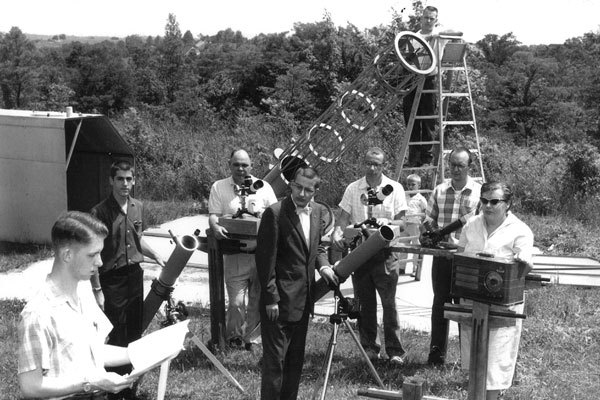Half a country away, Tom Van Flandern spent his youth exploring the vastness of space.
The naval astronomer found a love for the stratosphere as a boy when he struck a deal with his grandma to use his paper route money to pay for half of a telescope.
From there he immersed himself in the cosmos and through his exploration the stars aligned for him to meet the love of his life, Barbara.
The couple retired in Sequim for its nighttime view in 2005, but Tom Van Flandern was diagnosed with cancer Nov. 11, 2008, and died Jan. 9, 2009.
Van Flandern’s work recently came back into the spotlight because of his efforts leading the Project Moonwatch team in Cincinnati, Ohio, in the 1950s. The team was honored in early October with an Ohio Historical Society marker for its efforts observing satellites such as Sputnik 1.
Team member and lifelong friend Dennis Smith said Van Flandern led the team to be one of the best in the world.
Van Flandern was a student at Xavier University and Smith a high school sophomore when Van Flandern walked onto the team and was quickly appointed team leader. The team spent thousands of hours tracking satellites.
“Anything he did, he did with a passion,” Smith said.
One event that stands out from their countless nights under the stars is a satellite launch gone wrong.
Smith said they were given the time of launch and began timing when the satellite came by but soon saw another and another and another.
Something was wrong, Van Flandern realized. He sat down and began making calculations using a slide rule. Smith said a few minutes later, Van Flandern stood up and said, “The rocket blew up at this time, latitude and longitude. We should let them know.”
So Smith and Van Flandern went into the club’s meeting room and sent a telegram to the Smithsonian Astrophysical Observatory sharing the information.
Thirty minutes later, they received a phone call from the observatory asking to meet with Van Flandern.
He learned the observatory wanted to know his methodology, but he wouldn’t share his formulas. Smith said Van Flandern told them he would need them later on in his career.
“That’s when I recognized just how smart of a fellow he was,” Smith said. “I tended to believe what Tom told me from then on.”
Project Moonwatch spanned July 1957 to December 1958, and the Cincinnati Moonwatch Team was recognized by the Smithsonian Astrophysical Observatory as one of the leading teams worldwide in scientific contributions to the launching and optical tracking of earth satellites from 1957-1964.
Smith said the team was No. 1 in the world in observations for several months but eventually was beaten out by teams on the West Coast with better weather.
He advocated for the historical marker after rejoining the Cincinnati Astronomical Society more than a year ago. He said after Van Flandern died, he wanted to find a way to honor the team.
Love on Earth
Following his tenure with the Cincinnati Astronomical Society, Van Flandern earned his Ph.D. in astronomy from Yale University and became the chief researcher of celestial mechanics for the U.S. Naval Observatory.
“He tried to understand everything he could,” Barbara Van Flandern said.
Yet the master mathematician had simple tastes, she said.
He came from a poor beginning: His father left the family when Van Flandern was 7 and his mother died of breast cancer when he was 16.
Barbara Van Flandern said reading “The Stars” by H.A. Rey inspired her husband to investigate the stars, and when he received his first telescope, he said it was one of the best days of his life.
The couple met during a college mixer. Barbara had no interest in meeting someone new after recently breaking up with an ex. She went to the dance with some friends and Van Flandern approached her with a big smile and asked her to dance. She couldn’t refuse.
“When they first met it was love at first sight.” Smith said.
The couple married in 1963 and went on to have four children, Michael, Connie, Brian and Kevin.
“Tom is left brain and I’m extremely right brain,” Barbara said.
“That’s the big difference between us. One time I asked why is the moon orange and he’d said it’s because of there being so much pollution. I’m thinking romantic and he’s being scientific.”
“He was analytical and pure-minded,” she said.
Van Flandern continued to research controversial ideas, including the concept that there was a planet between Mars and Jupiter that exploded and impacted the surface of Mars. He explored the concept more in his book “Dark Matter, Missing Planets and New Comets: Paradoxes Resolved, Origins Illuminated” and his quarterly bulletin called Metaresearch.
Barbara said he believed in the possibility of intelligent life in space and tried to decipher whether the face in the Cydonia region on Mars was placed there.
For fun, the couple led eclipse trips across the globe, showing upwards of 300 people the best places to watch lunar eclipses.
Barbara said they were definitely a night owl couple and her husband’s love of the stars was infectious.
“I also didn’t like to go bed alone,” she said.
Reach Matthew Nash at mnash@sequimgazette.com.


